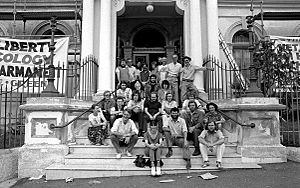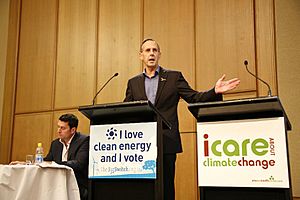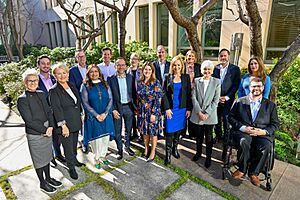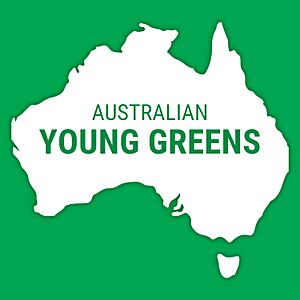Australian Greens facts for kids
Quick facts for kids
Australian Greens
|
|
|---|---|
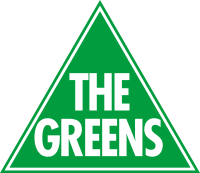 |
|
| Abbreviation |
|
| Leader | Larissa Waters |
| Deputy Leader | Mehreen Faruqi |
| Manager of Greens Business | Sarah Hanson-Young |
| Party Whip | Nick McKim |
| Founded | 1992 |
| Headquarters | Braddon, Australian Capital Territory |
| Newspaper | Green Magazine |
| Think tank | The Green Institute |
| Youth wing | Young Greens |
| Membership (2020) | |
| Ideology |
|
| Political position | Left-wing |
| Regional affiliation | Asia-Pacific Greens |
| International affiliation | Global Greens |
| Colours | Green |
| Slogan | A Future for All of Us |
| Governing body | National Council |
| Party branches |
|
| House of Representatives |
1 / 150
|
| Senate |
10 / 76
|
| State and territorial governments |
0 / 8
|
| State and territory lower houses |
17 / 465
|
| State upper houses |
14 / 156
|
| Party flag | |
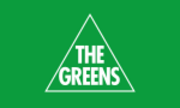 |
|
The Australian Greens, often called the Greens, are a left-leaning political party in Australia. They focus on environmental protection and social fairness. As of 2025, the Greens are the third-largest party in Australia by votes. They are the fourth-largest by the number of elected politicians. After the 2025 Australian federal election, Larissa Waters became the Leader of the Greens. Mehreen Faruqi is the Deputy Leader.
The party started in 1992. It brought together eight smaller state and territory parties. In their early years, a well-known politician from Tasmania, Bob Brown, was very important to the party. The Greens grew a lot in the early 2000s. The party has four main beliefs: caring for the environment, fairness for everyone, people having a say, and peace. The Greens' roots come from Australia's early environmental movement. This includes protests like the Franklin Dam controversy and the Green bans. It also includes the movement to stop nuclear weapons. The party began with the United Tasmania Group, which was one of the first green parties in the world.
After the 2025 Federal election, the Australian Greens had ten senators and one member in the House of Representatives. In 2020, they had over 15,000 members.
Contents
- The Greens' Journey: A Look at Their History
- What the Greens Believe: Their Core Ideas
- How the Greens Party is Set Up
- Who Supports the Greens?
- Election Results: How the Greens Have Performed
- Images for kids
- Current Federal Parliamentarians
- Other Important Members
- Who Donates to the Greens?
- See also
The Greens' Journey: A Look at Their History
How the Greens Party Started
The Australian Greens began with early environmental groups in Australia. One of the first was the United Tasmania Group. Other influences included the movement against nuclear weapons in Western Australia. Also, some worker groups in New South Wales were inspired by the Builders Labourers Federation's Green bans in Sydney. Environmental groups started working together in the 1980s. They held many important protests. Key people in these campaigns were Bob Brown and Christine Milne. They later won seats in the Parliament of Tasmania and helped form the Tasmanian Greens. Both Brown and Milne later became leaders of the federal Greens party.
The federal party was officially formed in 1992. It brought together more than a dozen green groups from different states and local areas. Some of these groups had been around for 20 years. After the national party formed, different regions still had their own focus. Bob Brown left the Tasmanian Parliament in 1993. In 1996, he was elected as a senator for Tasmania. He was the first person elected as an Australian Greens candidate to the federal parliament.
At first, the most successful Greens group was The Greens (WA). This group was separate from the Australian Greens at the time. Senator Jo Vallentine was replaced by Christabel Chamarette in 1992. Dee Margetts joined her in 1993. However, Chamarette lost her seat in the 1996 Australian federal election. Margetts also lost her seat in the 1998 Australian federal election. This left Bob Brown as the only Australian Greens senator.
The Bob Brown Years (2001–2012)
Growing Support for the Greens (2001–2004)
In the 2001 Australian federal election, Bob Brown was re-elected as a senator for Tasmania. A second Greens senator, Kerry Nettle, was elected in New South Wales. The Greens did not agree with the government's plan for processing asylum seekers offshore. They also disagreed with supporting the Afghanistan War after the September 11 attacks. The party called the Afghanistan commitment "warmongering." Brown and Nettle's work in the Senate helped more people support the party. It showed that the Greens were not just focused on one environmental issue. This helped them gain support from voters who were unhappy with the Labor party.
First Win in the House of Representatives (2002)
On October 19, 2002, the Greens won a seat in the House of Representatives for the first time. Michael Organ won the Cunningham by-election. In the 2004 Australian federal election, the Australian Greens had candidates in every House of Representatives seat. The Greens' main vote went up by 2.3% to 7.2%. This helped them win two more Senate seats. Christine Milne won in Tasmania and Rachel Siewert in Western Australia. This brought their total number of senators to four.
More Growth and Influence (2007–2010)
The Greens' national vote increased to 9.04% in the 2007 Australian federal election. Sarah Hanson-Young was elected as a senator for South Australia. This brought the number of Greens senators to five. Bob Brown was re-elected, but Kerry Nettle lost her seat.
In November 2008, Senator Christine Milne was elected as the deputy leader. In 2009, the Greens and the Liberal Party voted against Labor's plan for an emissions trading scheme. This happened after they could not agree on targets for cutting emissions.
Holding the Balance of Power (2010–2012)
The 2010 Australian federal election was a big moment for the Greens. The party received its highest vote ever. They also held the balance of power in the Senate. This means they had enough votes to decide if laws would pass or not. The Greens' Senate vote increased by four percent to 13 percent. They won a Senate seat in each of the six states. This brought the party to a total of nine senators from July 2011.
The Greens also won their first House of Representatives seat in a general election. Adam Bandt won the seat of Melbourne. He became a crossbencher in the first hung parliament since 1940. A hung parliament is when no major party wins enough seats to form a government on its own. Almost two weeks after the election, the Greens agreed to support a Gillard Labor minority government. This meant they would vote with Labor on important issues like confidence and supply. Labor was able to form a government with the help of the Greens and three independent politicians.
In April 2012, Bob Brown stepped down as leader of the Australian Greens. He retired from the Senate in June 2012.
The Christine Milne Years (2012–2015)
Christine Milne led the Australian Greens after being elected without opposition.
Federal Elections and Senate Wins (2013–2014)
In the 2013 Australian federal election, the Greens' main vote in the House of Representatives (lower house) was 8.7 percent. Their vote in the Senate (upper house) was also 8.7 percent. Even though their votes went down, the Greens gained more politicians in parliament. Adam Bandt kept his Melbourne seat. The Greens won four Senate positions, increasing their total to ten senators.
In the 2014 Australian Senate special election in Western Australia, the Greens won enough votes to re-elect Scott Ludlam. Their main vote increased from 9.5 to 15.6 percent.
Working with the Government (2015)
In December 2015, the Greens made a deal with the government. They passed a law that made large international companies share their tax information. This law also required big international companies to prepare "general purpose" financial statements. These statements show more tax details than before. The next year, the government and the Greens agreed on a 15% tax rate for backpackers. In return, environmental groups like Landcare received $100 million in funding.
Christine Milne stepped down as leader of the Australian Greens on May 6, 2015.
The Richard Di Natale Years (2015–2020)
Di Natale was elected as the leader of the Greens on May 6, 2015. This happened after Christine Milne resigned.
Election Results and Challenges (2016)
In the 2016 Australian federal election, the Greens' main vote in the House of Representatives (lower house) went up to 10.23 percent. However, it went down in the Senate (upper house) to 8.65 percent. Adam Bandt was elected for a third time in his Melbourne seat. Even though the Greens tried to win more seats in the lower house, they did not win any new ones.
The Greens also lost one Senate position in South Australia. This reduced their Senate members from ten to nine. This meant they had a total of ten Green members in the Parliament of Australia. This result was seen as disappointing. It caused some disagreements within the party. Former leader Bob Brown even asked Senator Lee Rhiannon to resign.
Changes in Parliament (2017–2018)
In 2017, Senators Scott Ludlam and Larissa Waters had to resign. This was because they had dual citizenship, which is not allowed for Australian politicians. Ludlam had citizenship in Australia and New Zealand. Waters had citizenship in Australia and Canada. After this, Adam Bandt and Rachel Siewert became temporary co-deputy leaders.
The 2019 Election and Leadership Change
In the 2019 Australian federal election, the Australian Greens received 10.4% of the main vote in the House of Representatives. The party kept the federal seat of Melbourne with Adam Bandt. In the Senate, all six Greens senators who were up for re-election kept their seats. These included Senators Mehreen Faruqi, Janet Rice, Larissa Waters, Sarah Hanson-Young, Jordon Steele-John and Nick McKim.
On February 3, 2020, Di Natale resigned as leader of the Greens. He also announced he would leave the Senate.
The Adam Bandt Years (2020–2025)
On February 4, Adam Bandt was elected as the leader of the Australian Greens. He was elected without opposition.
The 2022 Election: A Big Win
The Greens had a plan for the 2022 Australian federal election. They aimed to win nine key seats. Bandt said that polls suggested no major party would win enough seats to govern alone. He believed the Greens could work with Labor to "kick the Liberals out" and push for stronger action on climate change.
The party had its best election result ever. They won three seats in inner Brisbane: Elizabeth Watson-Brown in Ryan, Stephen Bates in Brisbane, and Max Chandler-Mather in Griffith. This increased their members in the House of Representatives to four. They also won a Senate seat in every state, increasing their senators to 12. This gave them the balance of power in the Senate.
On February 6, 2023, Victorian Greens senator Lidia Thorpe announced she would leave the Greens. She became an independent senator due to disagreements about the proposed Indigenous Voice to Parliament.
In mid-March 2024, the Greens said they would introduce a law to reduce the power of the two big supermarket chains, Woolworths Group and Coles Group. They wanted to force them to sell some of their businesses. The government did not support this bill, but the National Party did.
The 2025 Election and New Leadership
In the 2025 Australian federal election, the Greens lost party leader Adam Bandt in Melbourne. They also lost Stephen Bates in Brisbane and Max Chandler-Mather in Griffith. Labor won all three of these seats. When Bandt accepted the election results on May 8, 2025, Tasmanian Greens senator Nick McKim became the acting leader.
The Larissa Waters Years (2025–Present)
Queensland Senator Larissa Waters was elected as party leader on May 15, 2025. She was elected without opposition. Mehreen Faruqi continued as deputy leader. Sarah Hanson-Young was expected to run for leader but was instead elected as Manager of Greens Business.
On June 6, 2025, Senator for Western Australia Dorinda Cox left the Greens and joined the Labor party.
What the Greens Believe: Their Core Ideas
The Australian Greens are part of the worldwide "green politics" movement. Former party Leader Adam Bandt described the Greens as a social democratic party. The Greens' main document lists four key ideas for the party's policies: "fairness for everyone", "caring for the environment", "people having a say" and "peace and non-violence".
Key Policy Positions
Protecting Our Environment and Climate
The party supports environmentalism. This includes making more recycling facilities. They want to stop using single-use plastics. They also support conservation efforts. They aim to stop species extinction, habitat loss, and deforestation in Australia.
The Greens want Australia to use 100% renewable energy by 2030. They propose a Green New Deal. This means investing in renewable energy technology. It also means making Australian manufacturing stronger. Factories would need to produce things like solar panels and wind turbines. The party wants a publicly owned renewable energy company. This would help boost renewable energy and lower electricity prices for homes. To help with the move to clean energy, the party supports more lithium mining. The Greens also have plans to create jobs and apprenticeships. They want to build public housing to help with homelessness in Australia.
Money and Fairness
The Greens do not support tax cuts that only help the richest people. They believe these cuts lead to unfair differences in wealth. The Greens think all important services need enough money to meet community needs. They also want to bring back a publicly owned bank. The party wants a special tax on big company profits. They also want a wealth tax on billionaires. They aim to stop large international companies from avoiding taxes.
The party wants to make welfare policies much better. They suggest solving housing shortages and homelessness by creating affordable social housing. The party also wants to introduce rent caps to limit how much rent can increase. The Greens also propose increasing all income support payments to $88 a day. This would be $1,232 every two weeks. To help students, the party wants to forgive all student debt. The Greens also support free childcare and free public transport. Finally, the Greens propose to increase the minimum wage.
Green politicians have campaigned for free university and technical and further education. The party is against higher fees for degrees and cuts to university funding. They have asked for more money for public schools. The party also supports getting rid of all student debt.
Health and Well-being
The party supports universal health care. They want to expand Medicare to cover dental health care and mental health care. The Greens also support reproductive health rights.
Social Issues and Democracy
The Greens have supported many social issues. These include the legalisation of marriage equality. They also support the right to seek asylum and gender equality. The Greens also support policies they believe will make Australian democracy stronger. They want to "clean up politics." This includes limiting political donations. They also want to make the National Anti-Corruption Commission stronger.
Farming and Animals
For farming, the party strongly supports policies that help animal welfare and make farms stronger against climate change. The Greens strongly support reducing soil and water damage. They want communities to make decisions about this. They also want to help farmers dealing with climate change.
The Greens want to stop live animal exports. Instead, they want to invest in the local chilled meat industry. The Greens have also campaigned to ban greyhound racing and whaling. The party believes in stopping caged egg production and sow stalls. They prefer ethical farming practices. The party also wants to reduce methane from livestock. They plan to do this through research, animal health, and genetics.
Australia's Place in the World
On foreign policy, the party says it wants "Independent, transparent and accountable foreign and defence policies based on mutual respect."
How We Vote
The party supports proportional representation in the House of Representatives and local government. This means that the number of seats a party gets matches the percentage of votes they receive.
How the Greens Party is Set Up
Parliament
Federal Leaders
On November 12, 2005, the Australian Greens changed their rule about not having an official leader. They approved a way for a leader to be chosen by the Greens Parliamentary Party Room. On November 28, 2005, Bob Brown was elected as the Parliamentary Party Leader. He had already been seen as the unofficial leader. Each leader is said to represent a different group within the party.
The leader is chosen by agreement within the party room. If they cannot agree, they vote. All past Greens leaders have been elected without opposition.
Parliamentary Roles
Greens politicians are given their own portfolios. These are specific areas of responsibility. All portfolios are decided by the party. They might have different names than the government's portfolios. For example, the Greens have a Gun Control portfolio, which the government does not have.
The Greens divide portfolios into five main groups: "an equal society," "world-class essential services," "climate and the environment," "the green economy," and "a confident Australia."
National Council
The Australian Greens is set up as a federation. This means it has separate state parties that agree to a national rulebook. But these state parties still have a lot of freedom to make their own policies and run their own groups. The main decision-making group for the Australian Greens is the National Council. It includes representatives from each state or territory Greens party. It also has two members from the federal parliament, a representative from the Australian Greens First Nations Network (AGFNN, or Blak Greens), and national leaders like the National Convenor, Secretary, and Treasurer. As of May 2020, all seven of the party's main leadership roles were held by women. The National Council makes decisions by agreement. All policies made by this group must be approved by the members of the Australian Greens at the National Conference.
State and Territory Parties
The Australian Greens is made up of eight parties from each state and territory. The different Australian states and territories have different voting systems. All of these systems allow the Greens to win seats. As of 2024, the Greens hold at least one seat in all eight state and territory parliaments.
Five Greens members have become ministers at the state or territory level: Nick McKim and Cassy O'Connor in Tasmania (2010–2014); and in the ACT, Shane Rattenbury since 2012, and Emma Davidson and Rebecca Vassarotti since 2020.
Most state-based Green parties do not have one formal leader. Instead, they have a shared leadership structure. However, Tasmania, Victoria, Western Australia, and the ACT have chosen to have single leaders for their parties.
The current Australian Green member parties are:
| Party | Leader | Last state/territory election & current seat tally | Status | Federal representatives | ||||||||
|---|---|---|---|---|---|---|---|---|---|---|---|---|
| Lower House | Upper House | MPs | Senators | |||||||||
| Year | Votes (%) | Current seats | Votes (%) | Current seats | ||||||||
| Greens New South Wales | None | 2023 | 9.7 |
3 / 93
|
9.1 |
4 / 42
|
Crossbench |
0 / 46
|
2 / 12
|
|||
| Victorian Greens | Ellen Sandell | 2022 | 11.5 |
3 / 88
|
10.3 |
4 / 40
|
Crossbench |
0 / 38
|
1 / 12
|
|||
| Queensland Greens | None | 2024 | 9.9 |
1 / 93
|
N/A | Crossbench |
1 / 30
|
2 / 12
|
||||
| Greens Western Australia | Brad Pettitt | 2025 | 11.1 |
0 / 59
|
10.9 |
4 / 37
|
Crossbench |
0 / 16
|
1 / 12
|
|||
| Greens South Australia | None | 2022 | 9.1 |
0 / 47
|
9.0 |
1 / 22
|
Crossbench |
0 / 10
|
2 / 12
|
|||
| Tasmanian Greens | Rosalie Woodruff | 2024 | 13.9 |
5 / 35
|
N/A |
1 / 15
|
Crossbench |
0 / 5
|
2 / 12
|
|||
| ACT Greens | Shane Rattenbury | 2024 | 12.2 |
4 / 25
|
N/A | Crossbench |
0 / 3
|
0 / 2
|
||||
| Northern Territory Greens | None | 2024 | 8.1 |
1 / 25
|
N/A | Crossbench |
0 / 2
|
0 / 2
|
||||
Working Groups and Youth Wing
The National Council has set up different working groups. All Greens members can join these groups. Working groups give advice by creating policies or looking at the party's structure.
The Australian Young Greens is a group of Young Greens from each Australian state and territory. They form the youth part of the Australian Greens.
Who Supports the Greens?
The Greens usually get support from younger voters who have more education. The Greens gained many supporters from the Australian Democrats party after it declined. Many of the social and environmental policies the Democrats supported are now championed by the Greens. Like the Democrats, the Greens have more supporters who are university educated, under 40, work as professionals, own small businesses, and earn more than the average wage. Also, more working-class people have started supporting the Greens since the party began.
In 2019, a political scientist named Ian McAllister found that Greens voters often have a lot of "cultural capital." This means they have things like a university education. However, they might not own their own home, which means they have "asset poverty." Another political scientist, Todd Farrell, found in 2020 that Greens supporters are very loyal to the party. This suggests a big shift in Australian politics away from the main Labor and Liberal parties.
Election Results: How the Greens Have Performed
House of Representatives
| Election | Leader | Votes | % | Seats | +/– | Position | Status |
|---|---|---|---|---|---|---|---|
| 1993 | None | 196,702 | 1.83 |
0 / 147
|
No seats | ||
| 1996 | 188,994 | 1.74 |
0 / 148
|
No seats | |||
| 1998 | 238,035 | 2.14 |
0 / 148
|
No seats | |||
| 2001 | 569,074 | 4.96 |
0 / 150
|
No seats | |||
| 2004 | 841,734 | 7.19 |
0 / 150
|
No seats | |||
| 2007 | Bob Brown | 967,789 | 7.79 |
0 / 150
|
No seats | ||
| 2010 | 1,458,998 | 11.76 |
1 / 150
|
Confidence and supply | |||
| 2013 | Christine Milne | 1,116,918 | 8.65 |
1 / 150
|
Crossbench | ||
| 2016 | Richard Di Natale | 1,385,651 | 10.23 |
1 / 150
|
Crossbench | ||
| 2019 | 1,482,923 | 10.40 |
1 / 151
|
Crossbench | |||
| 2022 | Adam Bandt | 1,795,985 | 12.25 |
4 / 151
|
Crossbench | ||
| 2025 | 1,889,977 | 12.20 |
1 / 150
|
Crossbench |
Senate
| Election | Leader | Votes | % | Seats | +/– | Position | Status | |
|---|---|---|---|---|---|---|---|---|
| Up | Total | |||||||
| 1990 | None | 201,618 | 2.0 |
0 / 40
|
0 / 76
|
No seats | ||
| 1993 | 263,106 | 2.5 |
0 / 40
|
0 / 76
|
No seats | |||
| 1996 | 180,404 | 1.7 |
0 / 40
|
0 / 76
|
No seats | |||
| 1998 | 244,165 | 2.2 |
0 / 40
|
1 / 76
|
Crossbench | |||
| 2001 | 574,543 | 4.9 |
2 / 40
|
2 / 76
|
Crossbench | |||
| 2004 | 916,431 | 7.7 |
2 / 40
|
4 / 76
|
Crossbench | |||
| 2007 | Bob Brown | 1,144,751 | 9.0 |
3 / 40
|
5 / 76
|
Crossbench | ||
| 2010 | 1,667,315 | 13.1 |
6 / 40
|
9 / 76
|
Crossbench | |||
| 2013 | Christine Milne | 1,159,588 | 8.6 |
4 / 40
|
10 / 76
|
Crossbench | ||
| 2016 | Richard Di Natale | 1,197,657 | 8.7 |
9 / 76
|
9 / 76
|
Crossbench | ||
| 2019 | 1,488,427 | 10.2 |
6 / 40
|
9 / 76
|
Crossbench | |||
| 2022 | Adam Bandt | 1,903,403 | 12.6 |
6 / 40
|
12 / 76
|
Crossbench | ||
| 2025 | 1,859,974 | 11.72 |
6 / 40
|
11 / 76
|
Crossbench | |||
Images for kids
Current Federal Parliamentarians
House of Representatives
-
Elizabeth Watson-Brown MP (Ryan, Qld), 2022–present
Senate
-
Senator Sarah Hanson-Young (SA), 2008–present
-
Senator Larissa Waters (Qld), 2011–2017, 2018–present
Former Parliamentarians
- Senator Jo Vallentine, 1990–1992, Greens WA (first elected in 1984 for the Nuclear Disarmament Party)
- Senator Christabel Chamarette, 1992–1996, Greens WA
- Senator Dee Margetts, 1993–1999, Greens WA
- Senator Bob Brown (Tas), 1996–2012
- Michael Organ MP (Cunningham, NSW), 2002–2004
- Senator Kerry Nettle (NSW), 2002–2008
- Senator Christine Milne (Tas), 2005–2015
- Senator Rachel Siewert (WA), 2005–2021
- Senator Scott Ludlam (WA), 2008–2017
- Senator Richard Di Natale (Vic), 2011–2020
- Senator Lee Rhiannon (NSW), 2011–2018
- Senator Penny Wright (SA), 2011–2015
- Senator Janet Rice (Vic), 2014–2024
- Senator Robert Simms (SA), 2015–2016
- Senator Andrew Bartlett (Qld), 2017–2018
- Senator Lidia Thorpe (Vic), 2020–2023
- Max Chandler-Mather (Griffith, QLD), 2022–2025
- Stephen Bates (Brisbane, QLD), 2022–2025
- Adam Bandt (Melbourne, VIC) 2010–2025
- Senator Dorinda Cox (WA), 2021–2025 (joined Labor)
Senators Vallentine, Chamarette, and Margetts were elected as Greens (WA) senators. They served before Greens WA joined the Australian Greens. This means they were not considered Australian Greens senators at the time.
For current and former state parliamentarians, see the List of Australian Greens parliamentarians.
Other Important Members
- Clive Hamilton, Greens candidate for the 2009 Higgins by-election
- Chris Harris, former Greens Councillor for the City of Sydney
- Jean Jenkins, former Democrats Senator for Western Australia
- Jack Mundey, a union leader involved in the green bans
- Janet Powell, former Democrats leader
- Peter Singer, a moral philosopher and Greens candidate for the 1994 Kooyong by-election
- Brian Walters SC, a human rights lawyer and candidate for the state seat of Melbourne in the 2010 Victorian election
- Andrew Wilkie, former Greens candidate and independent federal member for Denison (2010–19) and Clark (2019–present)
- Julian Burnside AO QC, a barrister and human rights advocate, and candidate for the federal seat of Kooyong in the 2019 Australian federal election
- Jason Ball, a former Australian rules football player and mental health advocate, and candidate for Higgins in the 2019 Australian federal election
Who Donates to the Greens?
For the 2015–2016 financial year, the top ten donors to the Greens included: Graeme Wood ($500,000), Duncan Turpie ($500,000), Electrical Trades Union of Australia ($320,000), Louise Crossley ($138,000), Anna Hackett ($100,000), Pater Investments ($100,000), Ruth Greble ($35,000), Minax Uriel Ptd Ltd ($39,800) and Chilla Bulbeck ($30,000).
Since 2017, the Australian Greens have shared information about donations over $1,000 in real-time. They do this to make politics more open and fair.
See also
 In Spanish: Verdes Australianos para niños
In Spanish: Verdes Australianos para niños
- List of Australian Greens parliamentarians
- Tasmanian Labor–Green Accord (1989–1990)
- Australian Capital Territory Labor–Greens coalition (2012–2024)


